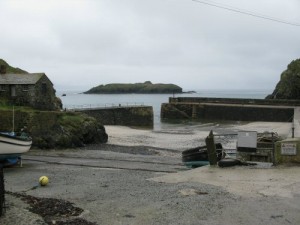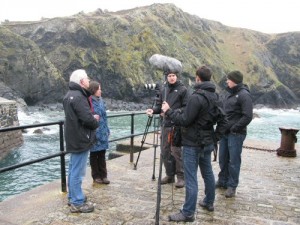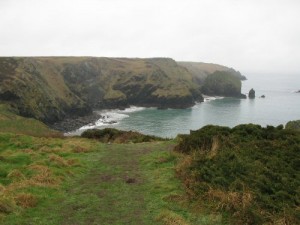
February 7, 2012, by Lucy
Location 1: Mullion Harbour, Cornwall
So we made it to Cornwall late last night and this morning set off for Mullion Harbour on the Lizard Peninsula, picking up cultural geographer Caitlin DeSilvey on the way. The film crew of Ben, Tom and Matt were already there, capturing cutaway shots of the harbour and surrounding dramatic coastal landscape.
The day began with quite a bit of mist and drizzle which meant the planned filming schedule was put aside and the interview between Steve and Caitlin delayed (this allowed a coffee break in the Mullion Cove Hotel high up on the cliff top, apparently built in expectation of the railway arriving in Mullion, an extension that never happened). With an improvement in the weather, the interview shots seemed to go very smoothly, in very few takes. This was an opportunity for Caitlin to tell us more about the history of the site and her work at the Harbour.
Once a busy pilchard fishing harbour, Mullion Cove has been protected from the elements by a substantial harbour wall since 1895. The wall was constructed in an attempt to revive the struggling fishing industry but ironically never really fulfilled this aim. Yet the harbour has become a much loved feature in the coastal landscape, today Mullion’s visitors come for recreation and quiet enjoyment and the coloured fishing boats, lobster pots and net store still support a small community of fishermen. I’d not been to Mullion before, but it really is quite a magical place and you can see why many people want it to stay as it is forever.
The National Trust acquired the Harbour in 1945 after a long period of neglect, and immediately began what would become an annual process of maintenance and repair activities which have cost over £1.5 million since 1945. Looking at a map you realise that this is a very exposed coast and it’s really no surprise that the walls suffer frequent storm damage, particularly through the winter. It was never a good place to build a harbour and recent damage was clearly visible on the southern breakwater. Prevailing narratives tend to project the long-term conservation of sites like Mullion indefinitely into the future but, the next time a big storm hits here, change will be embraced rather than resisted, and a managed retreat will slowly let the harbour go. Caitlin and Steve speculated what this ‘managed retreat’ might look like, but rather than a spectacular demolition(!) it is likely that some limited repair work, in concrete rather than the original serpentine rock, will take place for a number of years to come, allowing a more gradual process of letting go, although if a big storm hits it could be a rapid change.
Steve and Caitlin then had to do some walking shots along the harbour wall, and some close ups of hands, faces and eyes as the sound of the waves began to grow louder as the tide came in. After a lunch break heavier drizzle had set in and so Caitlin and I watched the crew and Steve film the ‘outro’ to the section on the cliff top, before all moving back down to the harbour to film the intro to the interview and some walking shots – this time quite a few takes were required but we think we got there in the end!
So, a full day in the field before Steve and I returned to Falmouth, Caitlin returned home, and Ben, Tom and Matt began their journey to the next stop of the tour.
For Steve and I, time to sample Rick Stein’s fish and chips….you can read more about Caitlin’s project at Mullion in the latest issue of Cultural Geographies 19(1):31-54.
Lucy Veale
Monday 6th February




Enjoying this Lucy- hope it’s all going well. Looks spectacular even in the drizzle. Safe trip to the next destination
Thanks Georgina, we’ve since made it safely to North Lincolnshire and on to Woodbridge, Suffolk. Filming seems to be going well, we’re hoping to have a sneak preview of some footage over dinner this evening before filming the introduction and conclusion to the film tomorrow…. please keep reading!
Brilliant photos Lucy. Hope ‘the making of’ is going well!
Me and a friend stopped off here whilst cycling once. I took some similar images to those above in very similar weather! Thanks for reminding me of this memory.
Hi James, Thanks for reading and for your comment!